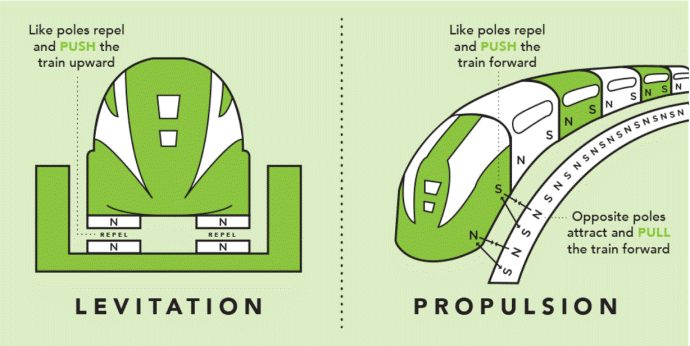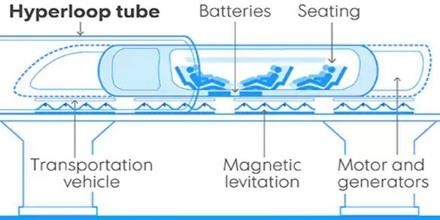Hyperloop is set to be the first new form of mass transportation humankind have developed in nearly 70 years, revolutionising the way we travel – and subsequently the way we live.
Prior to COVID-19, where Work-From-Home (WFH) was nothing but a rare luxury for some, transportation networks limited where one could live – given their requirement to travel to work.
Confined by crowded public transport networks and congested roads, we have been forced to live within the urban centres where we are employed, creating a multitude of issues.
Rent and real estate values are considerably higher given the limited amount of land available – a point made evident by the booming property market in Sydney, where many young buyers are now priced out of the market.
To avoid the pricing pressures of inner-city living, many live further away from the city, however, they must also face the reality of losing multiple hours a day travelling to and from work. This concept is known as an “urban sprawl”, and it’s what makes Sydney one of the world’s largest cities by area despite having a significantly smaller population relative to other major cities across the world.
Along with the increase in cost, living in urban centres carries consequences, including:
- Increased prevalence of respiratory diseases
- Children in urban areas have a significantly higher chance of developing respiratory diseases like asthma, due to higher levels of air pollution and greater confinement indoors where dust and other microbes are more prevalent.
- Environmental impacts
- Hotter temperatures through the replacement of natural vegetation with roads and houses, a concept coined an “urban heat island” (where bitumen and concrete retain more heat).
- Urban stormwater pollution, where both liquid and solid pollutants are washed off impervious surfaces (like concrete and pavements), and into oceans/rivers in the event of rain.
As economic activity continues to be centralised within urban centres, we need to do 1 of 2 things:
- Increase population density in urban centres and get comfortable with the fact that this will likely lead to further health and environmental impacts, and/or
- Develop transport infrastructure which enables a greater dispersion of populations
That’s where hyperloop comes in – a land-based transport solution, utilising electronic propulsion and magnetic levitation in low pressure, vacuum-sealed tubes, coined by Elon Musk as a “cross between a Concorde, a railgun, and an air hockey table”.
Through travelling at speeds of up to 1,200km/h (faster than a Boeing 747), hyperloop offers the potential of reduced population density, and increased mobility between cities.
In today’s note, we will go over hyperloop technology – how it works and the value it can add to existing transport networks.
How Does Hyperloop Work?
Hyperloop technology was first conceived by Elon Musk in 2012, initially sought out as an open-source, collaborative project for companies around the world.
It seeks to solve the two issues which currently hinder land-based transportation vehicles – friction and air resistance.
The removal of friction occurs from ‘passenger pods’ (the carriage), being magnetically levitated, with speed generated through the placement of magnets of opposite poles.

Source: US Department of Energy
Air resistance is removed through pods travelling within a vacuum-sealed tube – where the air pressure is equivalent to flying at 200,000 feet.

Source: Space Australia
What you essentially get is a land-based transportation method, which travels at the speed of commercial air travel, using a fraction of the energy, where the removal of friction and air resistance, and the use of magnetic propulsion significantly reduces the amount of energy required.
It is also significantly more environmentally friendly than any other means of transport, where the limited energy required to propel the pods can largely be generated from renewable sources – mainly solar panels on the top of the tubes, or from wind turbines in adjoining areas.
When compared to air travel, it is estimated that hyperloop is up to 10 times more energy efficient, and 4 times more efficient than rail, not to mention that the majority of its energy demands can be supplied by renewable sources.
Moreover, hyperloop is predicted to be more energy-efficient than cars and can deliver significant value through reducing the amount of freight on the roads.
The land required to set up hyperloop networks is also less than existing rail networks, given the reduced width of tracks (due to smaller pods), smaller tunnels (given the tunnel only has to be as wide as the tube itself), and a greater ability to turn at speed, and traverse inclinations (reducing the total distance covered).
It is also more convenient, given they are still being able to have stations within urban centres – instead of being situated on the outskirts of a city like most airports.
Despite the high speeds, they will be an extremely comfortable mode of transport, where passengers will barely be able to notice acceleration, deceleration, and sharp turns, with air pressures also being normalised as it would within an aircraft.
Sounds pretty good, doesn’t it?
What Value Can Hyperloop Add?
As mentioned earlier, we have an issue where we have too many people living too close to cities.
Sure, we could look to increase population density, and create metropolis’ similar to Tokyo, however, it will present elevated health and environmental consequences, as well as being the less preferred option – after all, who wants to live in a shoebox in a concrete jungle?
Without significantly increasing population densities, we can’t solve this issue, unless we move to more permanent WFH models (where people no longer have to travel into urban centres), or if we upgrade existing transport infrastructure through more roads/high-speed rail networks.
However, the expansion of existing rail/road networks would still be limited in its capability to speed up travel times, as these modes of transport are confined by friction and air pressure, as well as the potential constraints of houses or other buildings along existing road networks.
With the addition of hyperloop to our transport network, we can encourage greater spreads of populations, where one could live a 3-4hr drive from Sydney, but still make the commute every morning in ~30min.
Virgin estimates travelling between Sydney and Melbourne could be reduced to only 53mins, vs 3hr53m flying, 8hr39min drive or a 3hr high-speed rail trip (as per most recent estimates from the Federal Government).
Such a model could be effective in a country like Australia, where promises of high-speed rail networks have continually been proposed, but never constructed due to the high cost of development.
However, with such time savings, could Hyperloop be too efficient to ignore?
Whilst we’ve only touched on the benefits for population densities, Hyperloop would obviously promote greater economic activity, where business trips could be conducted easily between multiple state capitals, all within a day.
Where to From Here?
It may be some time before we see hyperloop technology on Australian shores, however, multiple companies have made significant progress in the field, the leader being Virgin Hyperloop.
Virgin Hyperloop conducted the first-ever successful test of hyperloop technology with human passengers last year, moving 2 passengers around a 500m test track at speeds of up to 172km/h.
Virgin’s model is different from other competitors, where it operates in a pod system, with each carriage completely separate from one another. These pods will primarily travel together but may split at some points throughout the journey should they have different destinations.
Virgin intends to begin carrying passengers in 2027, however, they will be subject to government regulations and potential construction issues, so this date might be pushed further out.
Whilst no development plans are set in stone, Virgin have been conducting viability studies on 10 shortlisted routes – including Edinburgh-London, Miami-Orlando and Chicago-Columbus-Pittsburgh.
For investors, Virgin Hyperloop is currently a private company, however, Branson has indicated that he intends to take it public at some point.
The process will likely be similar to that of Virgin Galactic (NYSE: SPCE), which listed via SPAC late last year.
The Hyperloop and Road Initiative
Given the proven effectiveness of hyperloop technology, the coming years will now focus on its viability from a cost standpoint.
For governments, investment into hyperloop technology sits within a sweet spot of solving 2 of the largest issues which are at the forefront of public attention, being:
- Housing affordability
- Emission reductions
For the Australian government, intervention in the housing market to date has largely only involved providing assistance to home buyers, which merely pushes up prices further, and doesn’t solve the overall issue.
Emissions reductions in the chasm of the transport industry could be achieved through providing support to those purchasing Electric Vehicles and improving public transport, however, this would not make considerable steps towards solving congestion issues and would be a long and expensive process.
Hyperloop would solve all of this, both in Australia and other developed countries, however, given the significant investments required, the only question will be – are governments willing to spend the money?
The views expressed in this article are the views of the stated author as at the date published and are subject to change based on markets and other conditions. Past performance is not a reliable indicator of future performance. Mason Stevens is only providing general advice in providing this information. You should consider this information, along with all your other investments and strategies when assessing the appropriateness of the information to your individual circumstances. Mason Stevens and its associates and their respective directors and other staff each declare that they may hold interests in securities and/or earn fees or other benefits from transactions arising as a result of information contained in this article.



